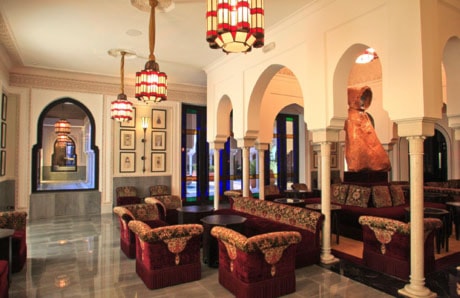MARRAKECH, Morocco — Winston Churchill invited Franklin Roosevelt here to relax following talks during the Second World War and Alfred Hitchcock shot some of The Man Who Knew Too Much in the hotel’s lobby — which has also been a haunt of the Rolling Stones, Charlie Chaplin, and many other Hollywood stars for nearly a century.
Now, after a three-year, US$176 million makeover, the Mamounia is opening again for business in the oasis gardens of Marrakech in southern Morocco.
A top interior designer has refurbished its rooms in Art Deco and Arabo-Andalusian styles, star-studded chefs have opened restaurants, and a sprawling spa has been added to the eight-hectare gardens of palm and olive trees to lure once again the rich and the famous to this legendary hotel set inside the Medieval ramparts of a world heritage site.
“There is only three golden rules about a palace of this standing,” says Jacques Garcia, the star French decorator who led restoration efforts: “Elegance, elegance, and elegance.”
Built in 1923 when Morocco was a French protectorate, the Mamounia merges the sober lines of Art Deco architecture with the intricacies of traditional arabesque decorations. The hotel has long been considered the masterpiece of this fusion of styles, unique to a handful of Moroccan buildings.
Its great marble hall leads to shaded courtyards where the trickle of small fountains echoes amid multicoloured tiling of rare refinement.
The pool house copies a 17th-century princely pavilion. Here sculptures in the Moroccan Zellige mosaic style are carved all over the plaster walls, overlooking the pool. Colonnades and corridors reminiscent of the Alhambra palace in Spain lead to the Churchill bar, complete with black and white photos of jazzmen, a panther-dotted carpet and red leather seating.
“It’s a very rare balance,” Garcia said as he toured the hotel ahead of its reopening on Sept. 29. Restoring such a place is like touching a myth, he said.
Garcia relied on old photographs from the original buildings, and leaned heavily on Marrakech craftsmen, who have largely kept alive age-old painting, woodcarving and decoration techniques.
“Morocco is probably the only place in the world where artisans can still paint a ceiling exactly like the original 16th-century one,” said Garcia.
The Mamounia is so emblematic of Morocco that many people in the North African country and beyond consider the hotel a national heritage — one of the very finest examples of Arabic craftsmanship and an embodiment of Moroccan art.
Before the renovation, many tourists flocking to Marrakech would try to pop in for a cup of mint tea and a chance glimpse at the building, even if they couldn’t afford to rent a room. Now the hotel will be more tightly sealed, but Didier Piquot, the manager, says outsiders can still visit if they make a booking at the restaurants.
“The Mamounia is to Marrakech what the Louvre is to Paris, everybody comes to see it,” also Garcia said.
“Only here, some can stay. It’s like spending a night at the museum.”
